 Ukraine c50 ships, 80,000 personal (1991-2025) c120 ships
Ukraine c50 ships, 80,000 personal (1991-2025) c120 shipsAlbeit Naval encyclopedia focuses mostly on the cold war and prior, the last 40 years had seen a lot of geopolitical changes and navies raising to new levels. In the current (May 2025) volatile and tension-ridden environment, it might be useful to complement the US-Chinese fleets by an overview of the Russian and Ukrainian Navies, especially since 2022. The Ukrainian Navy is a very peculiar subject as it existed in one way or another since the age of the Kievan Rus under Vladimir the Great and their Lodyas… The full picture.
A short bit about Ukrainian History
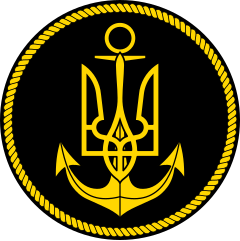 Long associated with the Russian sphere of Influence, the ancient land of the Scythians is now the second largest country in Europe. Already in antiquity the region was famous for its fertile plains, especially in Crimea, were ancient emporions (greek settlers) flourished in what became the Kingdom of Bosprorus and Chersonese, part of the Sarmatian Empire. It was the second largest provider of cereals after Egypt under the Roman Empire, and from the 6th century BC under Roman, and later Byzantine colonies. Goth, then Huns also settled in the region. It became the centre of Old Great Bulgaria and when Bulgar tribes migrated westwards notably, the Khazars settled there, just as the Sarmatians replaced the Scythians almost a millenia before.
Long associated with the Russian sphere of Influence, the ancient land of the Scythians is now the second largest country in Europe. Already in antiquity the region was famous for its fertile plains, especially in Crimea, were ancient emporions (greek settlers) flourished in what became the Kingdom of Bosprorus and Chersonese, part of the Sarmatian Empire. It was the second largest provider of cereals after Egypt under the Roman Empire, and from the 6th century BC under Roman, and later Byzantine colonies. Goth, then Huns also settled in the region. It became the centre of Old Great Bulgaria and when Bulgar tribes migrated westwards notably, the Khazars settled there, just as the Sarmatians replaced the Scythians almost a millenia before.
Colonized by the Slavic Antes people, the Ilmen Slavs and Krivichs also dwelled there in the early medieval era, but there was no established kingdom, only separate pastoralist tribes. It’s the rise of the Kievan Rus’ which put this region politically on the map, thanks to former vikings settling on what became Kiev, a rich trade network on a river connecting the Baltic and black sea. The Golden Age of Kyiv (largest and most powerful state in Europe 10-11th AD) whereas Vladimir the Great (980–1015) introduced Christianity in these lands. The cross was featured ever since on national emblems. However this golden age was ended by Mongol Invasions in the 13th cent. BC.
Already the Kievan Rus had a sizeable fleet composed of Lodyas, brought by the Rus, and inspired by nordic trade ships, relatively small to be carried on land and at ease on rivers. After a brief revival under Vladimir II Monomakh and his son Mstislav Kievan Rus disintegrated for good into separate principalities, paying tributes to the Cumans and Kipchaks. The rest was a succession of foreign occupation, under the Grand Duchy of Lithuania, Crown of the Kingdom of Poland, Crimean Khanate, Ottoman Empire, Polish–Lithuanian Commonwealth, and at last Russian Empire.
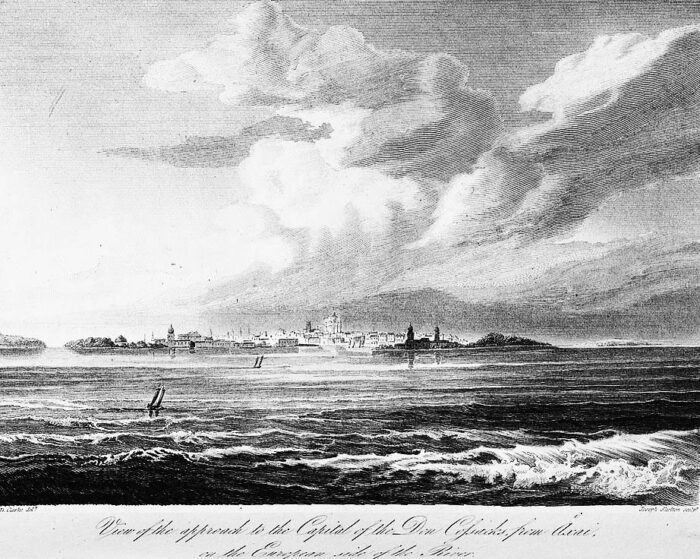
The Don Cossacks capital in 1800
If Ukraine had a prominent figure, these were the famous Cossacks, legendary horsemen, which fought wars in between Russian, Polish and Ottoman influences. The 1600s Cossack Hetmanate was a return of Ukrainian sovereignty but the annexation of Crimea by Russia in 1783, now called Novorossiya, sealed the fate of the country up to 1991. The country became a serie of semi-autonomous regions called successively the Southwestern Krai, Kharkov Governorate, and Chernigov Governorate. Ukrainian fought in WWI, troops fought on the Galician front.
But western Ukrainian people situated between Austria-Hungary and Russia suffered much with villages regularly destroyed and Ukrainians participatied on both sides. Some 20,000 ended in Austrian concentration camps. The 1917 revolution was not accepted by the majority of the population, and the region became a center od operation and later last refuge for “white russians” during the civil war. The wartime era even saw a short lived independent state created by Ukrainian nationalists until the Bolsheviks occupied the region again. Under Stalin, Ukraine was sanctioned for its ambiguous past by the Holodomor, a clear-cut genocide.
In WW2 Ukraine was one objective of Operation Barbarossa, invaded by Army group South and axis co-belligerents, Romanians, Bulgarians, Italians and even Spanish troops. In 1942, Stalingrad was the gateway to Baku and rich petrol fields which Hitler needed in his war of attrition. The Germans hoped to return Galicia and Ukraine as a whole as a puppet state but brutality caused the population to gradually turn against the occupants. Only a fraction of Ukrainians joined the axis like the Ukrainian Liberation Army. About 4.5 to 7 million fought with the Red Army. Marshal Semyon Timoshenko was from this region. Postwar Ukraine was in dire state: 700 cities and towns and 28,000 villages were destroyed and a famine crippled once again the ravaged lands until 1947. On the internaitonal sphere, the Ukrainian SSR was accepted by UN and later under Nikita Khrushchev Crimea was given to the Ukrainian SSR, despite being the host for the Russian Black sea fleet, as a gift.
Under him, Ukraine quickly recovered and soon reached high level of productions in all areas, especially food. Industry rebirth was accompanied by the construction of military plants and full integration of Ukrainian plants into the land army that was maintained during the cold war. Iconic models such as the T-64 were born here.
Apart the shadow of the Chernobyl Nuclear Power Plant explosion, Ukraine economically resisted better than other states of the USSR, although still poor.
The fall of the latter through Belavezha Accords on 8 December 1991 saw the creation of a newly independent state of Ukraine. Outright independence was proclaimed on 24 August 1991, later approved by 92% of the Ukrainian electorate in the 1st December referendum and the country reorganized itsel under its new President, Leonid Kravchuk. Its achille heal however was Crimea, as well as its links with the Russian military in many areas, notably industrials. Agreement were necessary also due to the presence of numerous nuclear weapons withing its border.
At the same time until 1999 the country suffered from a 60% fall of GDP and hyperinflation. In 1996 was introduced a national currency the hryvnia, but economical situation did only improved slowly. Oligarchs soon took hold of everything of value and later Ukraine was hit hard by the 2008 global financial crisis, and after some recovery, the Russo-Ukrainian War in 2014, and worst of all, the invasion of 2021. And even though the fleet there was still in Russian Hands, agreements granted the new state a small navy “from the heap of the black sea fleet”.
The Ukrainian Navy since 1600
The Cossaks Navy
If the modern Ukrainian Navy dates back 1991, there were various navies operated by ruling powers in Ukraine, the first of which being the Zaporizhian Cossack Fleet. A fleet of small reiveing boats operated by the Zaporizhian Sich Cossacks raided Ottoman settlements along the Black Sea coast. The typical vessel was called a chaika, itself derived from the Lodya. They met great successs, notably the sack of Trabzon. In 1615 a raid was done on Istanbul itself with perhaps 150 ships. The netx year, another Cossack fleet reached the Bosphorus. But a renewed Turkish fleet put an end to this raids in 1617. There was another raid on Istanbul on 1625 however, which this time forced the Sultan to temporarily flee the capital.
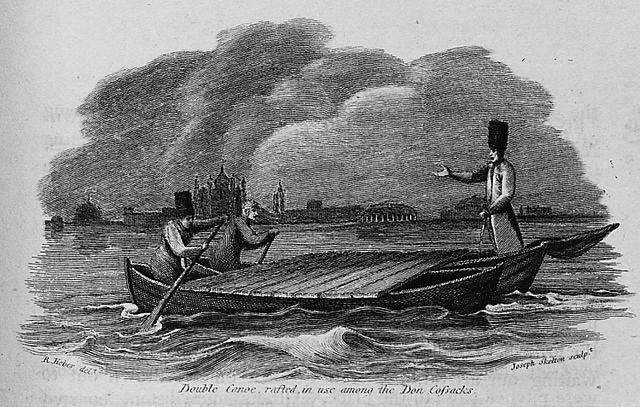
Don Cossacks double canoe, 1810
Cossacks positioned their ships in a way to have the sun always at their back, and their ships had a low profile, they were agile and small, offering little as cannons targets. Cossacks however considered their ships as platforms for boarding actions. They carried a wide variety of small arm, muskets, and attacked with grappling hooks, their famous curved sabre, several belt pistols and grenades. They usually tried to capture ships, not to sink them.
Ukrainian People’s Republic navy (1917–1921)
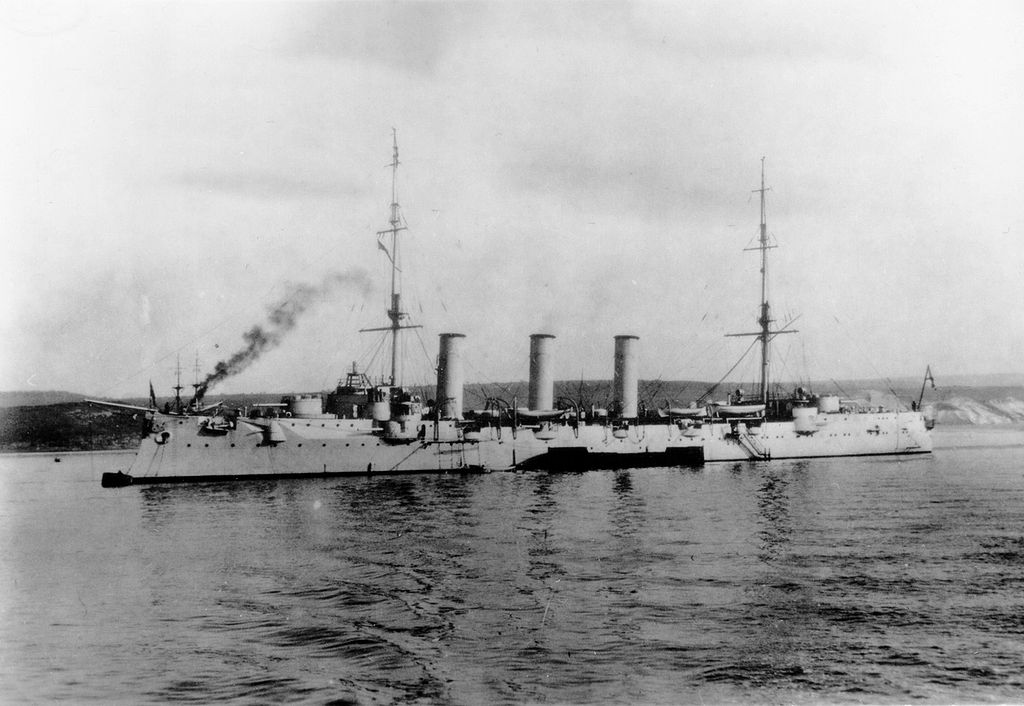
Pamiat Merkuria in 1917, the first Ukrainian Cruiser
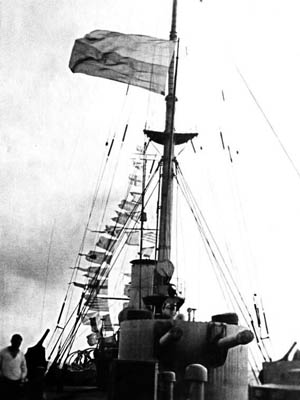 The 1917 Russian Revolution saw a revolt on many Russian Imperial Navy’s Black Sea Fleet in the hands of ethnic Ukrainians. These ships were transferred to the newly formed “autonomous Ukrainian People’s Republic”. Mikhail Sablin, commander of the black sea fleet, even raised the colours of the Ukrainian National Republic, on 29 April 1918. However the Ukrainian government soon lost control over coastal territories.
The 1917 Russian Revolution saw a revolt on many Russian Imperial Navy’s Black Sea Fleet in the hands of ethnic Ukrainians. These ships were transferred to the newly formed “autonomous Ukrainian People’s Republic”. Mikhail Sablin, commander of the black sea fleet, even raised the colours of the Ukrainian National Republic, on 29 April 1918. However the Ukrainian government soon lost control over coastal territories.
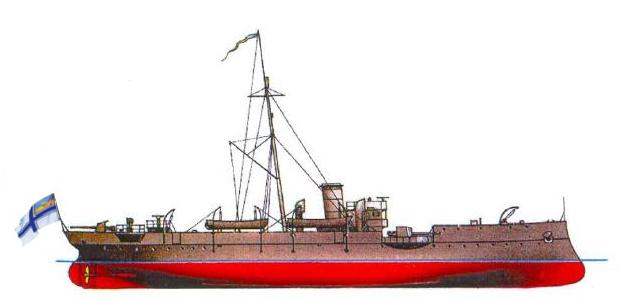
The Ukrainian gunboat Donets
The black sea fleet was under the “Tsentroflot” command, seeing much discussions between Ukrainian, Bolshevik, Menshevik, Social Revolutionaries and Anarchist to its possession. A collection of flags were hoisted hoisted and lowered over changes in the crew’s own political orientation. On 17 October 1917 2nd rank Captain Akimov became representative of the Central Council of Ukraine and a General Secretariat for Naval Affairs was created at Central Rada in Kyiv, then a ministry by January 1918 under D. Antonovich.
The Ukrainian Navy Staff was led by Captain Jerzy Świrski. Blue-yellow flags were hoisted on the masts of the destroyer Zavidniy and Russian cruiser Pamiat Merkuria.
By 22 November 1917 the Black Sea Fleet battleship Imperator Aleksandr III was renamed Volya and joined the new navy as well as several ships and submarines. By December 1917 the Ukrainian Black Seas Fleet squadron also included the Pamiat Merkuria and three destroyers, participating in the evacuation of the 127th Infantry Division from Trabzon to Ukraine. However by 29 December 1917 the Bolsheviks took over the fleet at gunpoint.
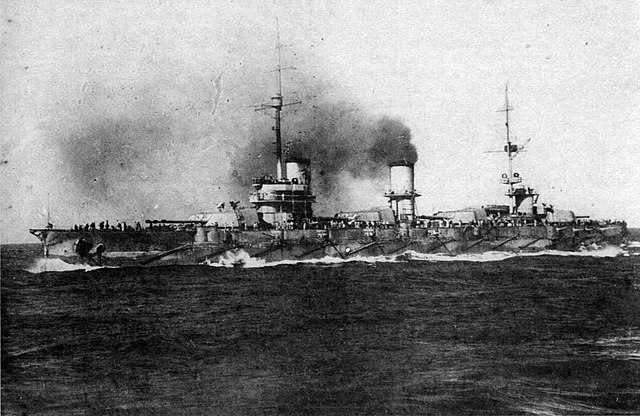
Volya, ex. Imperator Aleksander III, the most powerful capital ship of the short-lived Ukrainian Navy
Operation Faustschlag on Sevastopol by the Germans forced Admiral Sablin to negociate and cease hostilities, but terms were rejected and the advance continued. By April 1918 German-Ukrainian troops took back Crimea and by 29 April 1918, RaDM Sablin ordered to hoist Ukrainian national flags on all ships in Sevastopol, becoming the new CiC of the Ukrainian Navy.
The old battleship Georgiy Pobedonosets became its floating HQ. Meanwhile the Bolshevik held ships were forced to be moved under orders by Centroflot to Novorossiysk. By 30 April 1918, Sablin, which trusted the Bolsheviks also sailed to Novorossiysk under the St. Andrew flag and a few ships while the greater part of the Ukrainian fleet remained in Sevastopol (30 destroyers and torpedo boats, 25 auxiliaries, 7 battleships, 15 submarines among others) under RaDM Admiral Myhaylo Ostrogradskiy.
However this fleet was captured by the Germans on 1 May 1918 Germans considering the Bolsheviks violated the peace agreement. On 17 June the fleet was reinforced by one dreadnought and 6 destroyers from Novorossiysk, also captured. Those in Novorossiysk were scuttled under Lenin’s command. By July–November 1918 the Germans retransferred ships under Ukrainian command, now under Hetman Pavlo Skoropadskyi.
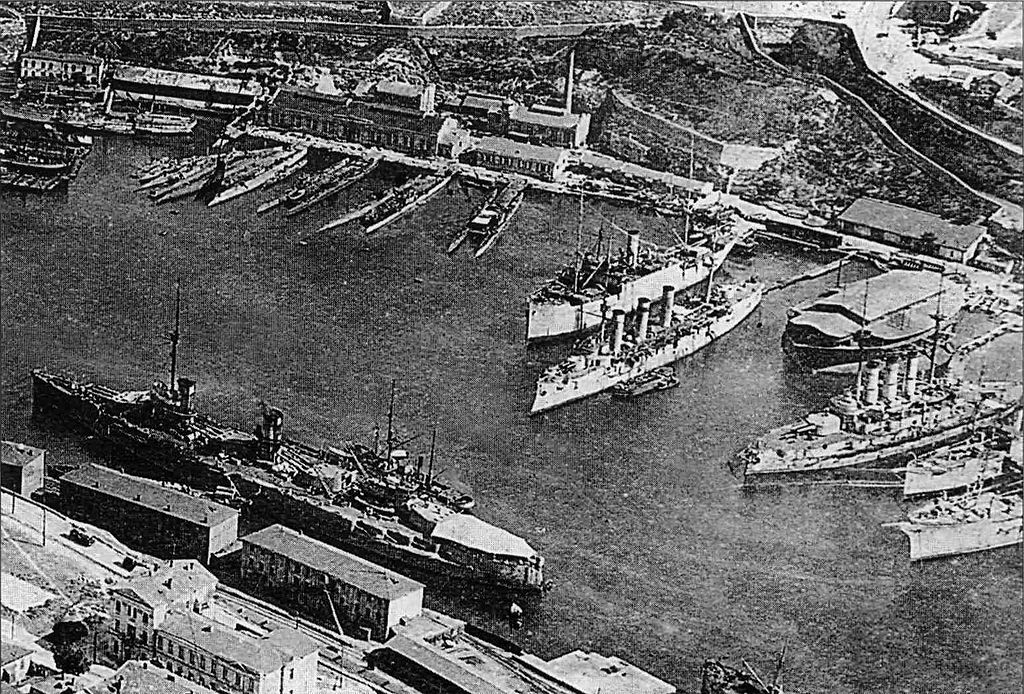
Sevastopol in 1918
Between Odessa and Mykolaiv were also anchored 20 minesweepers, 7 small cruisers, one dreadnought, 30 auxiliaries. In Sevastopol two pre-dreadnoughts remained. By 18 July the Naval Ministry established new naval ensigns, rank flags but kept the old Russian jack and tried to make the old glory of the Black Sea Fleet properly Ukrainian. On 17 September Ukraine also received 17 U-boats from Germany to bosler the fleet.
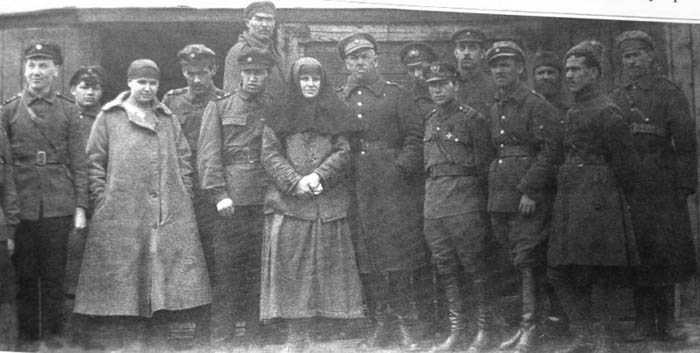
Ukrainian Marine Corps officers interned in Poland 1919-20.
By December 1918, after the German capitulation, the Entente fleet approached Sevastopol. Ukrainian Rear-admiral V. Klokhkovskyy asked to hoist Russian St. Andrew ensigns to reassure them. Still, the Entente captured the Black Sea Fleet and transferred ships to the Russian “White” forces. Marines corps however were constituted with Ukrainians under Kiev authority until 1921.
This ephemeral Ukrainian fleet was made of the bulk of the black sea fleet, existing From October 1917 to March 1918. It was even larger than the Austro-Hungarian Navy in 1914 with nine battleships, seven cruisers, 18 destroyers, 14 submarines, 16 patrol ships, 11 military transports and many other auxiliaries. All facilities and command structure were Ukrainian.
Some notablt came from the Baltic Fleet like the cruiser Krasnyi Krym, the the destroyer Ukraina and Gaidamak. But the core of the Sevastopol fleet comprised the recent dreanought battleships Volya and Imperatritsa Ekaterina Velikaya as well as the old Georgii Pobedonosets used as HQ and barracks ship, the cruiser Pamiat Merkuria, destroyer Zorkiy and Zvonkiy.
Ukrainians in the black sea fleet (1922-1990)
Despite the fall not only of the Russian Whites but also of an independent republic, the new RKKA thought on how best to reconstitute the old Black sea fleet. For more check the interwar history of the Soviet Navy. From then on, until the fall of USSR in 1991, Ukrainian sailors were integrated into the Russian Navy without any preferrence or regime. The situation is very much like the same as in the Austro-Hungarian navy of old between Austrians and Croats. Tensions were real but the Russian grip on Ukrainians was such that no revolt was possible at least until 1990. By then, the rapidly changing political situation started to rise nationalist sentiments among Ukrainian crews, with some ships being mostly crewed by Ukrainians. This led to a serie of defections soon in the Black sea fleet:
Ukraine’s motley fleet (1991-1997)
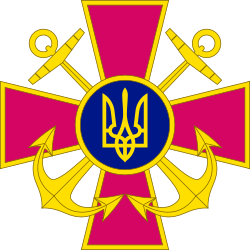 The first ship to change flag as her captain and crew were Ukrainian, was the Petya class Frigate SKR-112 (see the nomenclature). Her “career” was very short however due to her age and lack of funds. Soon other ships, mostly minor auxiliaries ir coastal units of the Black Sea Fleet managed to left for Odessa as well, this time more peacefully, but it would take until 1997 for the Black Sea Fleet to be officially divided between the two countries. Russian athorized the use of bases in the Crimea Peninsula based on a renewable ten-year lease basis until 2017. Of course it was not renewed and the annexation of Crimea ended the lease.
The first ship to change flag as her captain and crew were Ukrainian, was the Petya class Frigate SKR-112 (see the nomenclature). Her “career” was very short however due to her age and lack of funds. Soon other ships, mostly minor auxiliaries ir coastal units of the Black Sea Fleet managed to left for Odessa as well, this time more peacefully, but it would take until 1997 for the Black Sea Fleet to be officially divided between the two countries. Russian athorized the use of bases in the Crimea Peninsula based on a renewable ten-year lease basis until 2017. Of course it was not renewed and the annexation of Crimea ended the lease.
The motley fleet assembled was however of little use. Most were obsolete and/or inoperative socviet legacy vessels in poor general conditions due to the lack of maintenance already in Russian service. The new Ukrainian naval staff also lacked proper shore-based infrastructure to care for them. Still, Ukraine gained NITKA, the “Scientific testing simulator for shipborne aviation” which was a naval aviation training facility in Saky, and the special forces base in Ochakiv. However since the share was under-regulated, tensions rose from 2014.
Years of Neglect 1998-2014

From 1997 the lack of budget led to simply decommission and scrap most ships, generall the largest and oldest, with the remaining one poorly maintained. In 2009 the largest Ukrainian ship was the frigate Hetman Sahaydachniy (a Krivak class, former Soviet Border Guards ship) wa sbarely capable of long sorties without issues. Tensions were low enough that in 2010 there were Joint exercises between the Ukrainian Naval Forces and Russian Black Sea Fleet.
Meanwhile the Ukrainian naval staff planned a new corvette design from 2006 to be built in Odessa and completed FY2009 but nothing came of it.
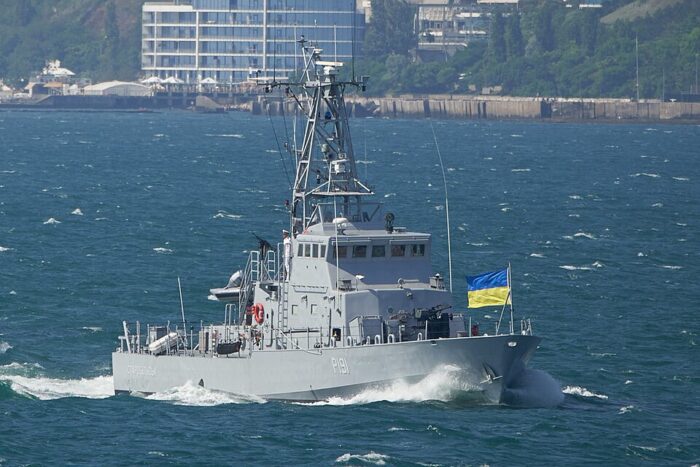
Starobilsk class: Three former Island class USCG cutters. Class: Starobilsk P191, Sumy P192, Fastiv P193, obtained 2019 and 2021, 164t Former USCGC Drummond, Ocracoke, Washington. Sloviansk was lost in action, sunk by a Kh-31 anti-ship missile.
On 19 December 2008 already, US Ambassador to Ukraine William B. Taylor, Jr. told the press MoD Yuriy Yekhanurov discussed acquisition of one up to three form OH Perry class Frigates. By December 2009, the Corvette design project was resurrected, renamed Volodymyr Velykyi-class, and was ultimately completed against all odds. A tender was aired for more corvettes with the Shipbuilding Research and Design Centerof Mykolaiv being selected as project developer. It had an endurance of 30 days as specified on a displacement of 2,500 ton for Mediterranean Operations. DCNS, MBDA, and EuroTorp were selected to deliver the armament with a Commissioning FY2016, four corvettes FY2021 and by March 2011 the program cost was evaluated to ₴16.22 billion. By the time, as of 2014 Navy personal amounted to 15,470. See below for details.
In between, the modern Ukrainian Navy saw its first overseas mission: As an Ukrainian ship carrying military cargo was hijacked off the coast of Somalia on 23 September 2008, released on 6 February 2009, Ukrainian officials precised their own special forces eliminated the pirates and retook the ship. In October 2013 the flagship frigate Hetman Sahaydachniy took part in Operation Ocean Shield, an anti-piracy mission in the Gulf of Aden, deployed for a 3-month mission, operating awith the Norwegian frigate HNoMS Fridtjof Nansen, Danish HDMS Esbern Snare, and USS De Wert. She also took part in EU-led Operation Atalanta on 3 January 2014 but was recalled on 3 March 2014 due to the annexation of Crimea.
The Crimean and Donbass
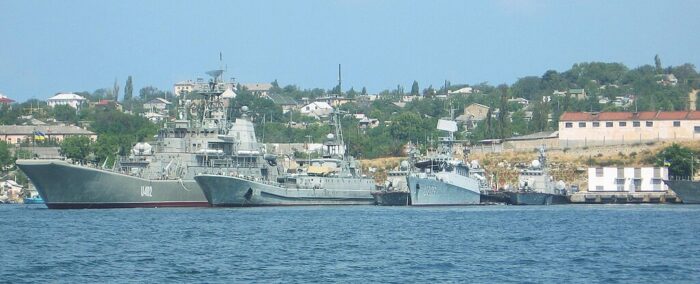
The Ukrainian Navy in Sebastopol, 2007, before the annexation.
Until the, the Ukrainian Navy only had a very modest force as its shores were limited. Its sitation was peculiar however as 12,000 of its 15,450 Navy personnel were stationed in Crimea and on 24 March 2014, at least 12 of its 17 ships in Sevastopol were forcibly seized by Russia, which saw two Ukrainian navy officers killed by Russian marines. Its main underground ammunition-storage site at the Inkerman valley was also captured and the helicopter-repair facilities. Its 750 men 1st Naval Infantry Battalion at Feodosia was arrested, equipment seized. The missile boats were also captured as their facilities, as 51 auxiliaries, most being eventually returned to Ukraine after internment as their military value was low. In 2015, thus, the Navy’s personnel fell to 6,500 and the Ukrainian Naval Infantry ceased to exist, without facilities or equipments. The 10th Saky Naval Aviation Brigade managed to have all its still flyable aircraft airborne redirected to mainland Ukraine on 5 March 2014 but the remainder were abandoned.
This war forced the Ukrainian Navy to relocate to Odesa, down to just 11 (mostly) small operational vessels, including a 1993 frigates and four corvettes. Russia returned a Polnocny-class landing ship to Ukraine however. On 8 April 2014, an agreement was reached to return interned vessels in exchange of a number or aircraft. 35 ships were returned until it was suspended. To this day, 16 ships are still interned. While the main fleet was in Odesa, the coast guard was relocated to Mariupol, Azov Sea. The flagship, Krivak class frigate Hetman Sahaydachniy was recalled Somalia as seen above, redeployed from Odesa to intercept Russian ships encroaching Ukrainian waters on 14 March 2014 and afterwards. Patrols soon resumed.
On 29 April 2018 Ukrainian President Petro Poroshenko and PM Volodymyr Groysman elebrated anway the 100th anniversary of Ukraine’s Navy and the Black Sea Fleet raised the colours.
There were also defections to Russia, notably members of the upper command, notably Vice Admiral Sergei Yeliseyev, and Rear Admiral Dmitriy Shakuro, Rear Admiral Denis Berezovsky.
Following the Revolution of Dignity and annexation of Crimea, Pro-Russian separatists in Donetsk and Luhansk Oblasts asked independence and started a war in Donbas. This was the infamous “little green men” episode. Ukrainian coast guard forces in Crimea fled to Mariupol but soon resumed patrolling on the border and notaboy started actions against separatists active in the Azov Sea, mutiplying incidents with the coast guard. On 27 January 2017 for example the Ukrainian diving support vessel Pochaiv was hit by sniper fire from the Tavrida drilling platform.
On 1 February 2017, an An-26 came under small arms fire from a drill rig while flying over the Odesa gas field in Ukraine’s EEZ. It was later made certain it was captured by Russian forces.
On 25 November 2018 three Ukrainian ships redeployed from Odesa to Berdiansk were damaged and captured by the FSB in what became the Kerch Strait incident.
In 2019 navigation and a near blockade of trade lines was observed, from Georgia, Bulgaria, Romania or Ukraine. From 25 July 2009 these closures amounted to 120,000 square kilometers, c25% of the Black Sea.
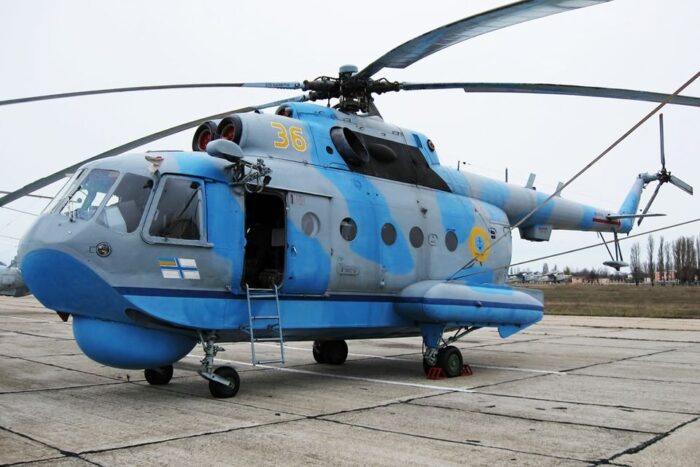
Ukrainian Mil-Mi 14 “Haze”. In 2013, its forced comprised ten aircraft, mostly naval helicopters, Ka-27, Ka-31 and Mil-Mi-14.
By August 2019, the Ukrainian reconnaissance ship Pereyaslav underway to Georgia for the exercise Agile Spirit 2019 was threated by a Russian ships while neutral waters, and she was soon forecibly blocked in her path by the ASW Grisha class corvette Kasimov, as the whole affair was filmed by an Ukrainian ship. However it stopped when a Turkish reconnaissance plane arrived close to the Pereyaslav. On 14 November (3rd International Conference for Maritime Security in Odesa), Ukrainian Navy commander Admiral Ihor Voronchenko reported Russian Tu-22M3 were reported practicing missile launches on Odesa. Such exercises were reported also on 10 July.
The fall of Crimea was the greatest hit to the Ukrainian Navy, which notably was deprived of its new corvettes built at the Mykolaiv Shipyard. Western powers, starting with the US, however contributed in modest way to rebuilt the Ukrainian lost capabilties over time.
The local construction of Gyurza-M-class gunboats was revived and a contract for 20 vessels to be completed by 2020 signed.
Another was the Project 58181 Centaur and Centaur-LK class armored assault craft, to re-equip the reconstituted Ukrainian marines brigade. But by 2018, the US offered Ukraine some of its former Oliver Hazard Perry-class frigates in reserve fleet, discussed in October 2018 but declined due to the maintenance costs of these ships.
Ukrainian shipbuilder Kuznya na Rybalskomu became the main new asset in naval construction for Ukraine and was financed.
The latest acquisitions as of January 2022 were sixteen US Mark VI patrol boats and associated equipment and by October 2020 the United Kingdom signed a MoU to provide a 10-year loan of up to £1.25 billion ($1.6 billion) to restore the Ukrainian Navy. By June 2021, HMS Defender visuted Odesa, to confirm the delivery of two Sandown-class minehunters. As fr local construction a contract was signed for four Ada-class corvettes and the development of a new supersonic cruise missile, the Bliskavka, to reocnstitute, alongside the older Neptun, a missile boats fleet.
The Navy also started to deploy Bayraktar Tactical Block 2 drones from July 2021.
The invasion of 2022
By early March 2022, Hetman Sahaidachny was scuttled in Mykolaiv to prevent capture by Russian forces while the patrol boat Slavyansk was sunk by an anti-ship missile launched by Russian aviation. On March 14, RT reported capture of a dozen Ukrainian ships in Berdiansk:
-2 Gyurza-M-class artillery vessels
-1 Matka-class missile boat Pryluky
-1 Project 1124P (Grisha II) class corvette (Vinnytsia, actually a museum ship)
-1 Zhuk-class patrol boat
-1 Yevgenya-class minesweeper
-1 Polnocny-class landing ship: Yuri Olefirenko
-1 Ondatra-class landing craft.
Independent confirmation (OSINT) of these captures negated however that was the case of Pryluky, Grisha, Yevgenya, the Yuri Olefirenko and Ondatra. Also 6 small boats, Adamant 315-class, Kalkan-M-class, and UMS 1000-class small patrol boats. The Naval Infantry bridgade was deployed to fight on land and took part in major land battles especially in the south. On June 3, 2022, the landing ship Yuri Olefirenko was shelled by Russian artillery near Ochakiv but remained unscathed. On June 22, 2022, BBC confirmed than RN personnel trained Ukrainian Navy personnel on Sandown Class Minehunters, albeit they were to be officially handed to the Romanian Navy instead. The Marine Corps lost one of its brigades in Mariupol, but was reorganized into an independent service from 23 May 2023.
Organization
(To come in a next update)
Full Nomenclature of the Ukrainian Navy
 SRK-112 (U132 Otaman Bilyi)
SRK-112 (U132 Otaman Bilyi)

SRK-112: First Ukrainian Navy ship, a Petya class frigate, when her crew on 20 July 1992 led by captain Mykola Zhybarev, raised the Ukrainian flag. The Navy HQ in Moscow considered this a mutiny. She SRK-112 left the Crimean peninsula base for Odessa, the Russian launched a chase, attempting to ram her. She took refuge in Odessa and was renamed provisionally U132 Otaman Bilyi when acquired. But her general state (she was built at Yantar in Kaliningrad and launched on August 15, 1967) and maintenance cost, led to decommission her on December 31, 1993. She was thus sold for scrap afterwards.
 Volodymyr Velykyi class Corvettes (2011)
Volodymyr Velykyi class Corvettes (2011)
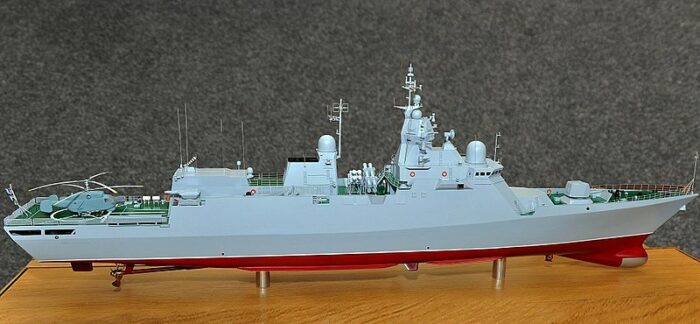
The Volodymyr Velykyi class, or Project 58250 is a planned class of frigates started as multipurpose corvettes and ordered by the Ukrainian Navy in 2005.
In 2002, the State Research and Design Shipbuilding Center developed the multi-purpose corvette “Hajduk-21”, for Leninska Kuznia in order to replace the legacy Soviet Grisha-class corvettes. But the Ministry of Defense (MoD) declined to fund it as too weak. It was decided to double the displacement, making this new ship compatible with NATO standards. On the initiative of MoD Anatoliy Hrytsenko on 9 August 2005 order for its development was allotted some ₴805 million.
It was to be larger than a corvette but smaller than a frigate, a nice spot for further developments, and the new project was developed in 2008 by State Research and Design Shipbuilding Center. 10 such ships were envisioned. The Black Sea Shipyard, under Smart Holding Group, with a Russian capital, was contracted.
Construction started as planned in 2011 with planned launching in 2012. However delays piled up until stopped in 2014 with Russian military intervention in Donbass.
At the end of 2017, work was announced to resumed with a new version of the ship mde compatible with more NATO systems, and a commission for the first ship in 2022, second in 2024, third in 2026, and fourth in 2028. By the spring of 2018, however, the Ukrainian Navy confirmed MOD priority was now to the armed forces, not the Navy, and funding was cut.
Construction could have been transferred to other shipyards, notably Mykolayiv Shipyard (former 61 Communards) and Kuznya na Rybalskomu (former Leninska Kuznya). In 2021, the Ukrainian MoD announced it would be classified as a frigate but as the EU refused to sell anti-ship missiles, Ukraine started its own program, which resulted in the Dnipro (first tests in 2016).
Construction was 17% done as of 2021, but completely stopped due to the Russian invasion, and very unlikely to restart.
Specs:
Displacement: 2,500-2,650 tonnes est.
Dimensions: 112 x 13.5 x 3.5 m ( 367 ft 5 in x 44 ft 3 in x 11 ft 6 in)
Powerplant: Not provided yet. Required speed 30 knots (56 km/h; 35 mph)
Specified Range: 4,000 mi (6,400 km) at 14 knots (26 km/h; 16 mph)
Crew: 110
Sensors (planned): 3D, medium range 3D, ACS, RWC, AF CSR, Sarmat FCRn, RTO/EW system
Armament: 1 × 76 mm/62 OTO Melara, 2×35 mm Oerlikon Millennium, 2×4 Neptune SSM, VLS 16x Dnipro SAM, 2×4 324 mm MU90 torp. NH90 NFH or Ka-27PL Helicopter, hangar.
 Hetman Sahaydachniy (1993)
Hetman Sahaydachniy (1993)

A Krivak III Frigate acquired after the share with the Black sea fleet. Hetman Sahaydachniy was the flagship of the Ukrainian Navy until 2022.
She was laid down on 5 October 1990 at Zalyv yard for the Soviet Border Troops as Kirov but after December 1991, she was acquired by the Ukrainian as she was already in Kerch, launched on 29 March 1992, completed on 2 April 1993 as Hetman Sahaidachny (U130) with a flag ceremony on 4 July 1993. She became the flagship of the Ukrainian Navy for less than a decade. In 1994 she was in France for the 50th-anniversary of D-Day, and by late 1995 was at Abu Dhabi “Idex-95” exhibition. Her visit to Norfolk was cancelled but she stopped in her career in Algeria, Bulgaria, Egypt, Georgia, Gibraltar, Israel, Portugal, Russia and Turkey. She was in refit and modernization in November 2006-2007 in Mykolaiv and in 2008 took part in “Operation Active Endeavour”.
She joined EUNAVFOR by early January 2014 for “Operation Ocean Shield” off the Horn of Africa. While in Greece the crew learned about the annexation of Crimea. She was back in Odesa on 5 March. On 14 March 2014 she approached a Russian group of ships in Ukrainian waters, which withdrew. In September 2014 she was in Odessa for refit. By May 2017 she had an engine failure. By July 2018 she took part in NATO Sea Breeze 2018. By January 2022 she was scheduled for a refit and upgrade but after the 2022 Russian invasion of Ukraine, she was scuttled in Mykolaiv, about to fall. On 3 March 2022 she was shown on all medias partially sunk and confoirmed scuttled on 4 March by the Ukrainian MOD, likely it was decided and acted upon on 28 February 2022, to prevent capture. She is still in that conditions today, still emerging in shallow waters, but the immersion damage probably means she is now an irreversible write-off.
Specs:
See KRIVAK class
 P153 Pryluky CPV (1980)
P153 Pryluky CPV (1980)
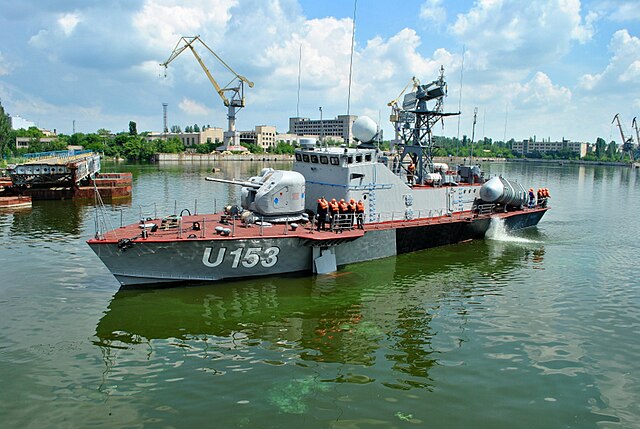
Ex Matka class hydrofoil (1977), reconverted as the patrol boat P153 Pryluky. Built at Sredne-Nevsky Shipyard, commissioned in 1980. She was returned to the Ukrainian Navy from Crimea in May 2014. She served as Missile boat 1991–2018 with the missiles removed, so she is now a pure patrol boat.
Matka class (Project 206MR) Pryluky P153, launched 1980, 257t, active as Patrol boat in Odessa. She was converted into a patrol boat with the removal of its P-15 Termit anti-ship missile system.
 Skadovsk CPV (1990)
Skadovsk CPV (1990)
Zhuk class (Project 1400M) legacy boat Skadovsk P170 (1990, 39.7t), previously named Haidamaka. In refit in Mykolaiv as of late 2021. Status Unknown, attached to the Odessa base.
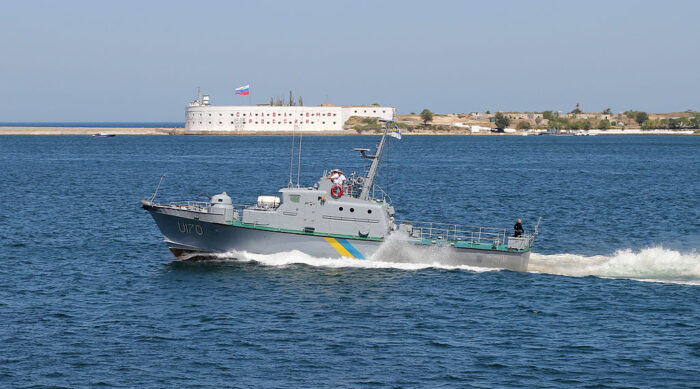
Zhuk 1400M type CPV.
Legacy small patrol gunboats of the PO-2 class, 1972-73: AK-03 P171, Rivne P172, AK-02 P173. Attached to the Ochakiv naval base. 1 unidentified PO-2 destroyed by a Russian ZALA Lancet strike on 17 April 2023, possibly more of the type based in Kyiv. PO-2 (project 376). Initially P171 AK-03, P172 Rivne, P173 AK-02 had been built in 1972 at the Yaroslavl Shipyard. They were used as Harbor boat 1991–2015. Two more were mobilised into the Navy after the Russian invasion of Ukraine, in a new river flotilla.
 Starobilsk class OPVs (2019)
Starobilsk class OPVs (2019)
P191 Starobilsk (ex-USCGC Drummond), P192 Sumy (ex-USCGC Ocracoke), P193 Fastiv (ex-SCGC Washington)
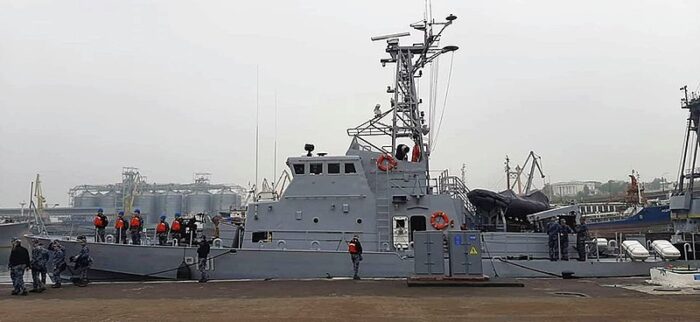
US Help: Three ex-Coast Guard ships transferred pre-invasion, in 2019 for the first, and 2021 for the last two. Built originally at Bollinger Shipyards as Island class Patrol Boats, dating back respectively from 1988, 1986 and 1990.
Specs:
Displacement 164 tons
Dimensions: 110 x 21 x 6.5 ft (34 x 6.4 x 2 m)
Propulsion: 2x Paxman-Valeta 16-CM RP-200M: 30+ knots (56 km/h; 35 mph)
Range: 9,900 miles, 6 days endurance
Crew: 18 (2 officers)
Armament: 1x 25 mm Mk 38 machine gun, 2 × .50 HMGs, RHI (90 HP outboard engine)
 Gyurza-M-class gunboat (Project 58155)t (2012)
Gyurza-M-class gunboat (Project 58155)t (2012)
Akkerman, Berdiansk, Nikopol, Kremenchuk, Lubny, Vyshhorod, Kostopil, Bucha (BK-01 to 08)
Class: Berdyansk P175 (2016), Nikopol P176 (2018), Kostopil P180 (2020), Bucha P181 (2023). Based in Odessa and Bucha in Kiev.
Berdyansk and Nikopol were captured in the Kerch Strait incident, returned to the Ukrainian Navy on 18 November 2019. One unidentified Gyurza-M was damaged by a Russian Lancet strike around November 4, 2022 or June 2023. 54 tonnes.

Under Project 58155 Gyurza-M, these are Ukrainian designed and built stealthy armored gunboat. The first two were laid down at the Kuznia na Rybalskomu Yard in October 2012. Nine planned by 2017. “Gyurza” is the Levant viper. The first ships were commissioned in December 2016 and a new contract for twenty vessels was scheduled for completion by 2020, but as for now, the serie stopped at the 8th vessels BK-08 Bucha, completed in May 2023.
On 25 November 2018, Berdyansk and Nikopol were seized by the Russian Navy, captured while trying to cross the Kerch Strait for Mariupol in the Sea of Azov. Three Ukrainian crew members were injured during the attack. They were returned on 18 November 2019 but in “sub-par condition” according to Ukrainian medias.
After the fall of Berdiansk, P 179-Vyshhorod and P 174-Akkerman were captured. After the siege of Mariupol, P-177 Kremenchuk and P-178 Lubny were also captured. By May 2023, 4 were active, incl. three captured by Russia, one sunk and raised, and the two captured and returned in 2018, repaired and reactivated in 2020. On 4 November 2022 one ship was damaged by a Lancet drone, as recorded on video by another UAV, a first.
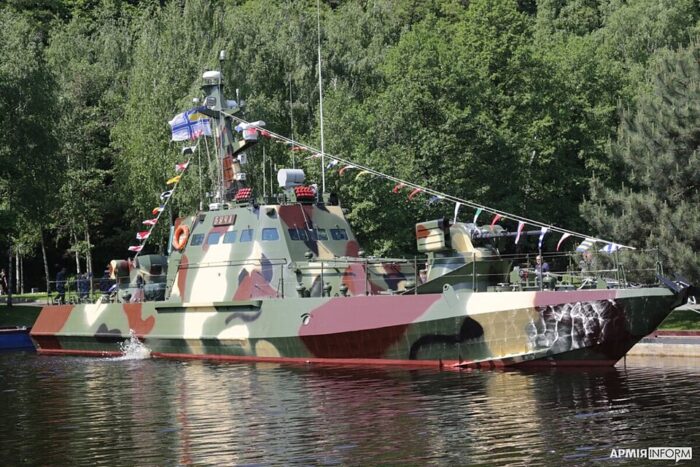
Specs:
Displacement: 54 tons
Dimensions: 23 x 4.8 x 1m (75 ft 6 in x 15 ft 9 in x 3 ft 3 in)
Speed: 25 knots (46 km/h; 29 mph) RA 900 miles (12 knots)
Crew: 5, armament 2 × BM-5M.01 Katran-M CIWS.
 Irwin class CPVs
Irwin class CPVs
Class: P182 Irpin, P193 Reni
NAVY 18 WP type patrol boats, Former Estonian Navy ships built in 2021. Transferred to the Ukrainian Navy in 2024. The Estonian Navy keeps Roland and Risto.
16 ships planned by the Estonian Navy, also purchased by the Royal Oman Police.
Specs:
Dimensions: 17.25 x 5.42 x 1.6 m (56 ft 7 in x 17 ft 9 in x 5 ft 3 in)
Propulsion: 2 × Volvo Penta D13-1000 diesels with fixed pitch propellers
Performances: 33 knots (38 mph; 61 km/h), 230 nmi (430 km) at 25 kn (46 km/h) range
Crew: 6. Simrad nav radar, 1× 0.5 in HMG/FN Herstal Sea DeFNder RWS, 2 × 7.62 mm GMPG
Ballistic protection.
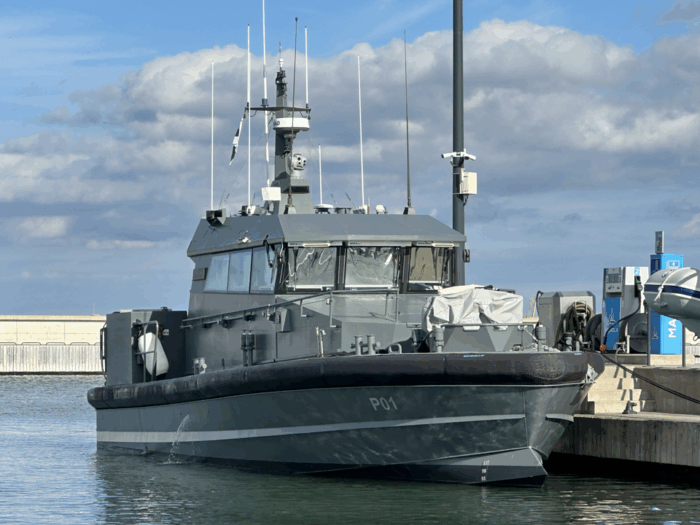
Irpin P182, Reni P183, transferred in 2024, former Estonian Navy ships. Light MG and navigation radar.
 Yuri Olefirenko
Yuri Olefirenko
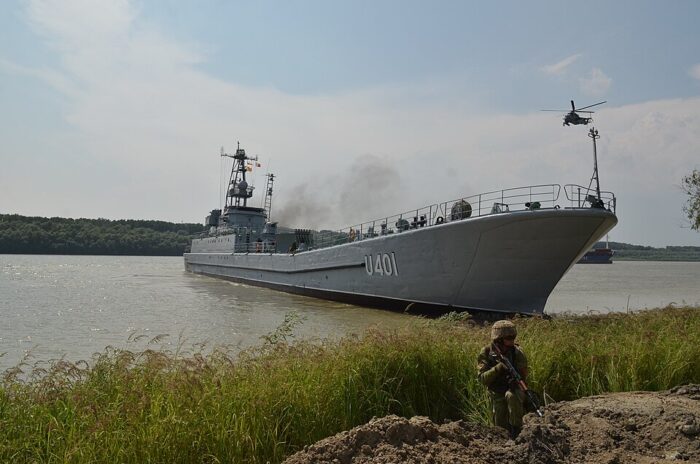
A Polnocny class LST (Project 773), pennant L(U)401, legacy ship commissoned on 1971, 1,192t. Previously SDK-137, then Kirovograd, before being ceded to Ukraine. Still listed active.
Current status unknown, she left Crimea on 19 April 2014 and was claimed destroyed in 2023. Based in Ochakiv.
 Kentavr class FAC (Project 58181)
Kentavr class FAC (Project 58181)
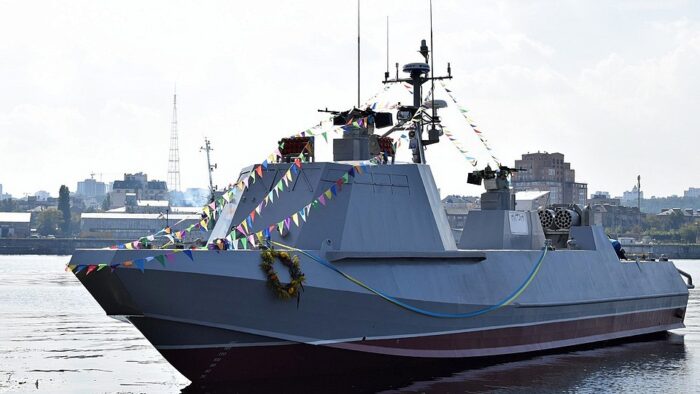
Malyn (L452) is the only one in class so far. This prototype for a new class of FACs failed to pass state tests as of 6 February 2022. In commission since 2019, but not active, albeit in service at least from April 2022. Claimed damaged by a Russian missile strike near Snake Island.
Eight vessels planned, two commissioned, one in cosntruction, unlikely to be resumed, also known as the Centaur-class fast assault craft. The project 58181 was developed by State Research and Design Shipbuilding Center, based on the legacy Gyurza-M-class gunboats, in 2015. First contract signed in 2016. By September 4, 2018, launching ceremony for the first, of a revised project, as 58503 «Centaur-LK». On September 20, the second was launched. On November 19, 2018, they were sent to Odessa to be worked out and reached 50 knots thanks to Hamilton Jet water jet. Autonomy five days. 12.7 mm RWS and 40-mm rocket, plus two 80-mm rocket-launchs but no missiles. But apart speed they failed their sea trials, leading to the order being cancelled and to a criminal conviction. By 6 February 2022, they were commissioned but still inactive.
Specs:
Displacement: 47 tons
Dimensions: 24.3 x 4.8 x 1 m (79 ft 9 in x 15 ft 9 in x 3 ft 3 in)
Propulsion: 2 × Hamilton Waterjet, 35 knots, RA 500 nmi (930 km; 580 mi) at 11 knots.
Sensors: Navigation radar, Optoelectronic monitoring system, Detection sensors of laser emission
Armament:2 × 12.7 mm HMG RWS, 1 × 40 mm rocket launcher, 2 × 80 mm rocket launcher
Vital spaces protected by bullet-proof steel.
 Chernihiv class Minehunter
Chernihiv class Minehunter
Commissioned in 2023, two ex-British Sandown class miunehunters transferred after the invasion of Ukraine after a refit, to clear out path for its export trade: Chernihiv M310 (Former HMS Grimsby) and Cherkasy M311 (HMS Shoreham). Supposed by Babcock International.
 Bereza class minehunter (Project 130)
Bereza class minehunter (Project 130)
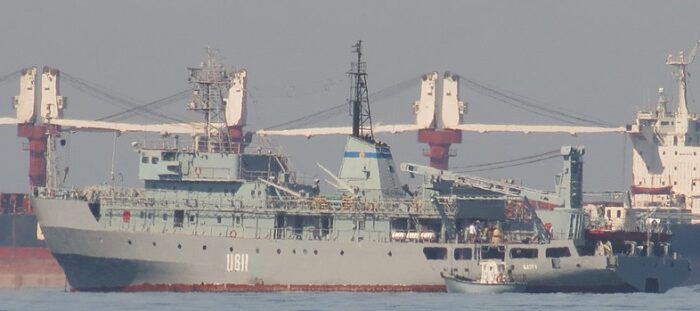
Balta, Former Soviet Navy degaussing ship (pennant U811) returned to the Ukrainian Navy from Crimea in April 2014. Launched initially in 1987, 2096t. Damaged in a storm after hitting the pier at Snake Island in 2021, repaired and returned to service in 2022.
 Simferopol A505 ISR ship
Simferopol A505 ISR ship
Project 502, 2021 1,220t ship, Odesa base, Current status unknown, possibly damaged in combat in 2025.
 Pereyaslav A512 ISR ship
Pereyaslav A512 ISR ship
Project 1824B 1986 legacy Spy ship 912t, Ochakiv base, Current status unknown. Possibly damaged in combat in 2022.
 Horlivka A753
Horlivka A753
Project 1849 legacy ship, 1965. 2178t, freight ship based in Ochakov, turne to the Ukrainian Navy in April 2014.
 Other Misc. vessels
Other Misc. vessels
Shostka A852 (Project 419 Sura, Laid up, returned to the Ukrainian Navy from Crimea in April 2014)
Project 1387 Korosten A853. 1965, 52.5t returned in 2014.
Bryza class Project 772U: Dobropillya A854, Pivdennyi A855 (1974-75) 142.6t, based in Ochakiv and Odessa.
More to come.
 40 PB class SPB (2020)
40 PB class SPB (2020)
Six Metal Shark combat patrol boats announced delivered by the US in June 2022 as part of a package of 18 vessels, coastal and riverine patrol boats from US stocks. Metal Shark confirmed in the Ukrainian Sea Guard.
 Sea Ark Dauntless (2011)
Sea Ark Dauntless (2011)
Like above, part of the 18 light patrol boats package, 11 delivered 2022, some numbered 216, 232, 419 and 806.
 Small unit riverine craft
Small unit riverine craft
2 (launched 2004-2005), RHIB type, delivered in 2022.
Read More/Src
Books
Links
Ukraine (generic)
Ukrainian_Navy
on youtube.com
List_of_active_Ukrainian_Navy_ships
https://bwb.ee/vessel/navy-18-wp

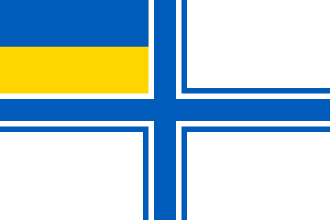
 Latest Facebook Entry -
Latest Facebook Entry -  X(Tweeter) Naval Encyclopedia's deck archive
X(Tweeter) Naval Encyclopedia's deck archive Instagram (@navalencyc)
Instagram (@navalencyc)





 French Navy
French Navy Royal Navy
Royal Navy Russian Navy
Russian Navy Armada Espanola
Armada Espanola Austrian Navy
Austrian Navy K.u.K. Kriegsmarine
K.u.K. Kriegsmarine Dansk Marine
Dansk Marine Nautiko Hellenon
Nautiko Hellenon Koninklije Marine 1870
Koninklije Marine 1870 Marinha do Brasil
Marinha do Brasil Osmanlı Donanması
Osmanlı Donanması Marina Do Peru
Marina Do Peru Marinha do Portugal
Marinha do Portugal Regia Marina 1870
Regia Marina 1870 Nihhon Kaigun 1870
Nihhon Kaigun 1870 Preußische Marine 1870
Preußische Marine 1870 Russkiy Flot 1870
Russkiy Flot 1870 Svenska marinen
Svenska marinen Søværnet
Søværnet Union Navy
Union Navy Confederate Navy
Confederate Navy Armada de Argentina
Armada de Argentina Imperial Chinese Navy
Imperial Chinese Navy Marinha do Portugal
Marinha do Portugal Mexico
Mexico Kaiserliche Marine
Kaiserliche Marine 1898 US Navy
1898 US Navy Sovietskiy Flot
Sovietskiy Flot Royal Canadian Navy
Royal Canadian Navy Royal Australian Navy
Royal Australian Navy RNZN Fleet
RNZN Fleet Chinese Navy 1937
Chinese Navy 1937 Kriegsmarine
Kriegsmarine Chilean Navy
Chilean Navy Danish Navy
Danish Navy Finnish Navy
Finnish Navy Hellenic Navy
Hellenic Navy Polish Navy
Polish Navy Romanian Navy
Romanian Navy Turkish Navy
Turkish Navy Royal Yugoslav Navy
Royal Yugoslav Navy Royal Thai Navy
Royal Thai Navy Minor Navies
Minor Navies Albania
Albania Austria
Austria Belgium
Belgium Columbia
Columbia Costa Rica
Costa Rica Cuba
Cuba Czechoslovakia
Czechoslovakia Dominican Republic
Dominican Republic Haiti
Haiti Hungary
Hungary Honduras
Honduras Estonia
Estonia Iceland
Iceland Eire
Eire Equador
Equador Iran
Iran Iraq
Iraq Latvia
Latvia Liberia
Liberia Lithuania
Lithuania Mandchukuo
Mandchukuo Morocco
Morocco Nicaragua
Nicaragua Persia
Persia San Salvador
San Salvador Sarawak
Sarawak Uruguay
Uruguay Venezuela
Venezuela Zanzibar
Zanzibar Warsaw Pact Navies
Warsaw Pact Navies Bulgaria
Bulgaria Hungary
Hungary

 Bundesmarine
Bundesmarine Dutch Navy
Dutch Navy Hellenic Navy
Hellenic Navy Marina Militare
Marina Militare Yugoslav Navy
Yugoslav Navy Chinese Navy
Chinese Navy Indian Navy
Indian Navy Indonesian Navy
Indonesian Navy JMSDF
JMSDF North Korean Navy
North Korean Navy Pakistani Navy
Pakistani Navy Philippines Navy
Philippines Navy ROKN
ROKN Rep. of Singapore Navy
Rep. of Singapore Navy Taiwanese Navy
Taiwanese Navy IDF Navy
IDF Navy Saudi Navy
Saudi Navy Royal New Zealand Navy
Royal New Zealand Navy Egyptian Navy
Egyptian Navy South African Navy
South African Navy






























 Ukrainian Navy
Ukrainian Navy dbodesign
dbodesign